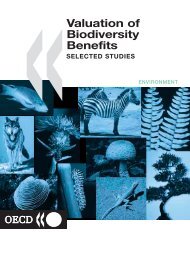Untitled
Untitled
Untitled
- No tags were found...
Create successful ePaper yourself
Turn your PDF publications into a flip-book with our unique Google optimized e-Paper software.
Division of National Agenda ProjectsViral InfectiousDisease Research CenterRESEARCHERSHaryoung Poo haryoung@kribb.re.krDevelopment of a new vaccine adjuvant and study of itsmechanismDevelopment of new candidates for universal vaccinesJeong-Ki Kim jkim@kribb.re.krEvaluation of the efficacy of newly developed vaccines inanimal modelsEvaluation of the efficacy of the vaccine adjuvant inanimal modelsSurveillance and genetic characterization of influenzaviruses circulating in our circumstanceDaesub Song sds1@kribb.re.krApplication of adjuvant candidate to large animal modelsStudy of interspecies transmission of influenza virusesSurveillance of mammalian derived influenza viruses inKoreaDoo-Jin Kim joongsu@kribb.re.krDevelopment of universial influenza vaccinesStudy on mucosal immune system and development ofmucosal vaccinesRESEARCH AREASDevelopment of new vaccine technologies includingsubunit, DNA, and universal vaccines against viralinfectious diseasesDevelopment of a new vaccine adjuvant for influenzavaccines, using polymer (poly-gamma-glutamate) nanoparticles,together with investigation of the immunemechanism of the adjuvantBasic research on influenza pandemics, includingsurveillance and genetic characterization studies ofinfluenza viruses and antiviral strategiesDirector Haryoung PooT + 82-42-860-4157F + 82-42-879-8498E haryoung@kribb.re.krACHIEVEMENTSDevelopment of new vaccine technologies, including subunit, DNA, and universalvaccines, against current and future pandemic influenza virusesSeveral candidates of subunit vaccines have been developed via prokaryotic and eukaryoticprotein expression systems, using the H1 HA of a of the recent pandemic influenza A(H1N1) 2009 virus. We have succeeded in the mass production of highly pure HA proteinsfor use as antigens on vaccination and have currently evaluated their efficacies as vaccinecandidates in animal models.Development of a new vaccine adjuvant for influenza vaccines, using polymer (polygamma-glutamate)nano-particles, and the investigation of the immune mechanism ofthe adjuvantAs an efficacious vaccine adjuvant candidate, we have developed nano-particlesconjugated with poly-gamma-glutamate, which induced a high level of NK cell-mediatedcytotoxicity and IFN- °V secretion in a mouse model in our previous study. Study of theimmune mechanism of the adjuvant has revealed that it strongly induces both humoraland cellular immune responses. The in vivo efficacy evaluation of the polymer nanoparticleadjuvant has been completed in various animal models using a pandemicinfluenza A (H1N1) vaccine; the polymer nano-particle adjuvant was able to increase thevaccine efficacy much higher than the existing adjuvants, such as alum and squalenebasedadjuvants.Basic research on pandemic influenza, including surveillance and geneticcharacterization studies of influenza viruses and antiviral strategiesWe have isolated influenza viruses from fecal samples of wild migratory birds (mainlyducks) on a regular basis. We have completely identified the positive isolates and havegenetically and pathogenically characterized them. In addition, we have evaluated in vitroand in vivo activities of some candidates of antiviral agents.SELECTED PUBLICATIONSHaryoung Poo (Corresponding) Cancer Immunol Immunother. 59(11):1727-37.Human papillomavirus type 16 E6-specific antitumor immunity is induced by oraladministration of HPV16 E6-expressing Lactobacillus case in C57BL / 6 miceHaryoung Poo (First) Chem Biodivers. 7(6):1555-62.New biological functions and applications of high-molecular-mass poly-gamma-glutamicacidHaryoung Poo (Corresponding) Cell Prolif. 43(6):584-93.Identification of tyrosine-nitrated proteins in HT22 hippocampal cells duringglutamate-induced oxidative stressJeong-Ki Kim (First) Proc Natl Acad Sci U S A. 107(24):11044-9.Puzzling inefficiency of H5N1 influenza vaccines in Egyptian poultryInfluenza pandemics generally occur following the emergence of new strains of influenza viruses that can be transmitted tohumans from other animal species and spread easily within the human population on a worldwide scale. An influenza pandemicof this nature is regarded as a global disaster, threatening public health with high morbidity and mortality.Therefore, it is necessary to formulate plans to counter current and future influenza pandemics. The overall objective of ourcenter is to develop new vaccine technologies and antiviral strategies to broadly address protective immune responsesagainst various sub-types of influenza viruses, especially the current pandemic influenza virus (novel 2009 influenza A [H1N1])and the highly pathogenic avian influenza virus, which are potential candidate viruses of future influenza pandemics.84 KRIBB Annual Report 2010KRIBB Annual Report 2010 85












